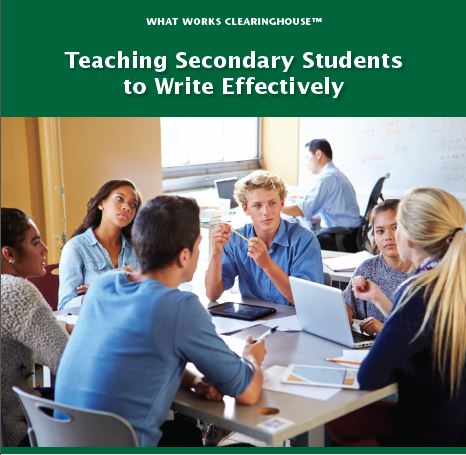EDITOR'S NOTE: Dr. Steve Graham was the head of a panel of experts that assisted the What Works Clearinghouse in developing recommendations for its practice guide on effective writing for secondary students. We invited Dr. Graham to author this blog about the guide and a January 18 webinar on its recommendations.
By Steve Graham, Warner Professor in the Division of Leadership and Innovation, Arizona State University

Effective writing is a vital component of students’ literacy achievement and a life-long skill that plays a key role in postsecondary success. For more than 30 years, I’ve focused my research on how teachers can help students become strong writers, how writing develops, and how writing can be used to support reading and learning. Much progress has been made in the field of writing instruction, and summarizing and sharing these findings will help teachers implement evidence-based practices. Using effective instructional practices will help ensure our students become adept at using writing to support and extend learning, argue effectively and fairly, connect and communicate with others, tell captivating stories, and explore who they are as well as reflect on their experiences.
Recently, the What Works Clearinghouse (WWC) released a new practice guide to address the challenges of teaching writing to secondary students. Teaching Secondary Students to Write Effectively offers three evidence-based recommendations for helping students in grades 6–12 develop effective writing skills. The first recommendation focuses on teaching students to use writing strategies to plan, think critically, and effectively convey their ideas. The second recommendation suggests integrating reading and writing to emphasize key features of text. Finally, the third recommendation describes how to use a formative assessment cycle to inform writing instruction.
The guide includes practical instructional tips and strategies for each recommendation that teachers can use to help students improve their writing. You’ll find over 30 examples to use in the classroom, including sample writing strategies and prompts and activities that incorporate writing and reading.
I’d like to invite teachers, administrators, and others to join me for a webinar on the recommendations in this practice guide, Wednesday, January 18, at 3 p.m. (ET). During the webinar, we will discuss the guide’s three recommendations and give teachers in all disciplines usable guidance on how to implement them in the classroom. We will also discuss potential challenges educators may face when implementing the recommended practices and provide advice on how to overcome those challenges.

Developing the Practice Guide
The WWC develops practice guides with the support of an expert panel. The panelists combine their expertise with the findings of rigorous research to produce specific recommendations. I was honored to chair this panel, which also included Jill Fitzgerald, from the University of North Carolina at Chapel Hill and MetaMetrics; Linda D. Friedrich, from the National Writing Project; Katie Greene, from Forsyth County (Ga.) Schools; James S. Kim, from Harvard University; and Carol Booth Olson, from the University of California, Irvine.
For this practice guide, WWC staff conducted a systematic review of the research—a thorough literature search identified more than 3,700 relevant studies. After screening each study, 55 studies were found to use eligible research designs and examine the effectiveness of the practices found in this guide’s recommendations. The recommendations are based on the 15 studies that meet the WWC’s rigorous standards. For each of the recommendations, the WWC and the panel rate the strength of the evidence that supports it. Appendix D in the guide presents a thorough summary of the evidence supporting each recommendation.